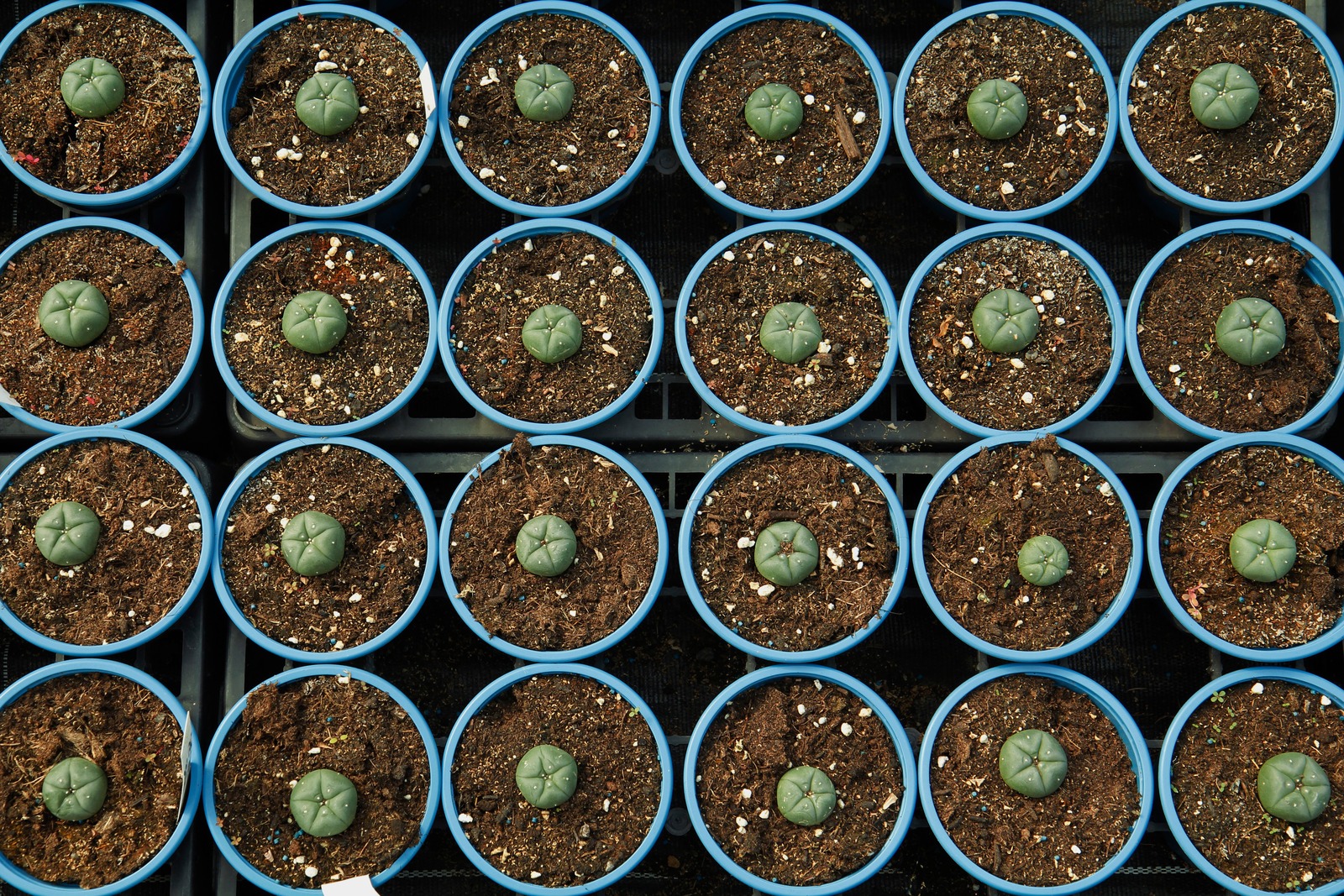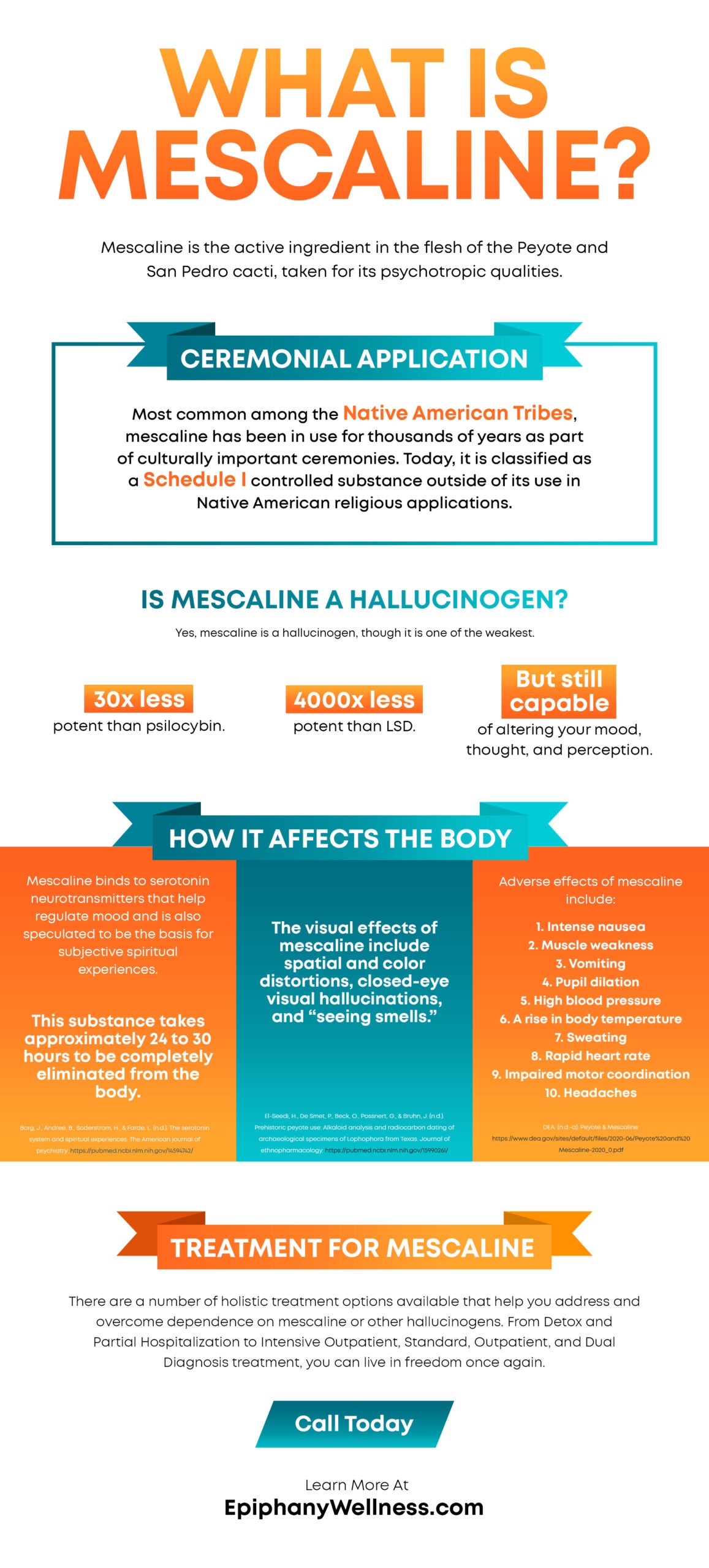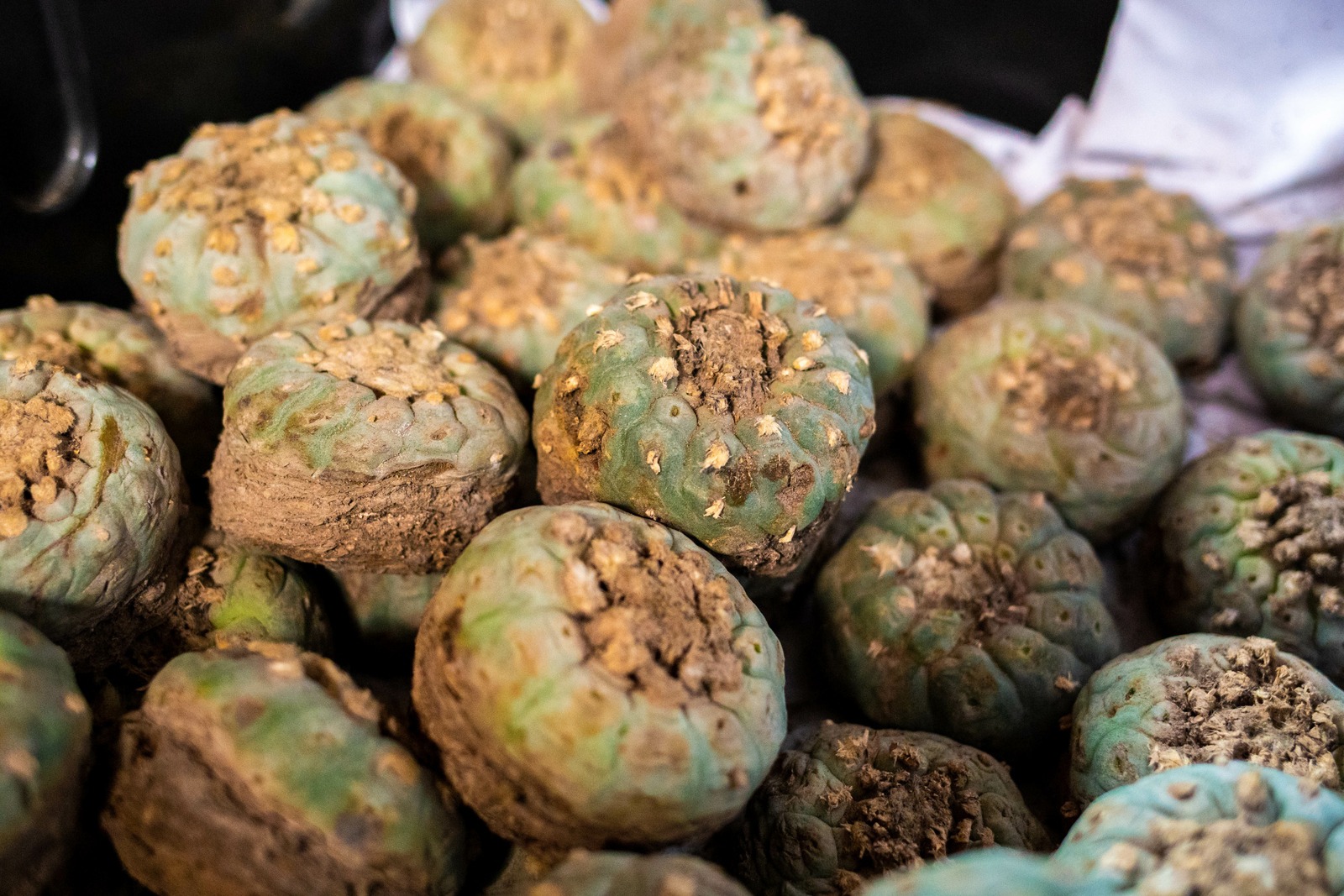What Is Mescaline? [Infographic] Usage, Side Effects, Dangers, and Health Risks

- Mescaline is a psychotropic substance commonly associated with Native American culture.
- Mescaline is the active ingredient in Peyote and San Pedro cacti.
- Though historically restricted, Native Americans gained legal protection for the use of peyote, which contains mescaline, in religious ceremonies with the American Indian Religious Freedom Act Amendments of 1994.
- Mescaline has generally positive, moderate psychedelic effects.
- Like anything, mescaline can be abused with potentially severe negative effects.
Everything You Need to Know About Mescaline
Mescaline is the active ingredient in the Peyote cactus, likely harvested and used by Native Americans for over 5700 years.
It has psychedelic properties and is an indispensable sacrament of religious ceremonies of the Native American Church. It grows in southern Texas and northern Mexico.
While it has a low potential for abuse, some people do report substance cravings.
What are Psychedelics?
Psychedelics are a class of drugs which is known to change the user’s mood, thoughts, or perceptions.
While psychedelics in the US, such as LSD, are commonly associated with the counter-cultural movement of the 1960s, indigenous people have been harvesting plants, fungus, and cacti for their psychedelic properties for thousands of years.
Depersonalization, or feeling disconnected from your own body, is a common side effect of psychedelic drugs.[1]
While psychedelics are not physically addictive, users can form mental dependencies on them. Using them in unsafe environments, such as while operating a motor vehicle, could cause serious injuries to yourself and others.
What is Mescaline?
Mescaline is the active ingredient in Peyote and San Pedro cacti. The flesh of the cacti must be harvested to experience mescaline’s effects.
Mescaline has psychotropic qualities, which make it ideal for spiritual practices amongst Native Americans. There is strong evidence that Native Americans have used peyote–and, consequently, mescaline– for its psychedelic properties for over 5700 years.[2]
While the geographic range of San Pedro cacti is considered of “little concern” to conservationists, the geographic range of Peyote cacti is considered “vulnerable.”[3][4]
Mescaline’s Mechanism of Action
Mescaline has agonist properties when it attaches to serotonin receptors in the brain; it also binds to dopamine receptors.[5] Since mescaline can bind with dopamine receptors, it has a slight possibility of forming physical dependencies, though this has yet to be formally studied.
Serotonin is a neurotransmitter that helps regulate mood. While the presence of serotonin is associated with regulating mood states like happiness, cheerfulness, and positivity, it is also speculated to be the basis for subjective spiritual experiences.[6]
The lack of serotonin is associated with sadness, depression, and generalized anxiety.
Despite not being highly lipid-soluble, mescaline can cross the blood-brain barrier, although less efficiently than more lipid-soluble substances.[7] It has a long duration of action.
Half-Life of Mescaline
The plasma half-life of mescaline is approximately 6 hours.[8]
The half-life of any given substance is the time needed for only 50% of a substance to remain in the body. To be statistically eliminated from the body (<95%), 4 to 5 elimination half-lives are required.
It takes approximately 24 to 30 hours to eliminate mescaline from the body.
Methods for Administering Mescaline
Mescaline is traditionally consumed by chewing or brewing in a tea, and it can also be encapsulated or, less commonly, smoked.
While synthetic mescaline does exist, the natural consumption of mescaline from cacti like Peyote and San Pedro is more common, particularly in traditional and religious contexts. Mescaline-containing cactus material can be soaked in water to create a psychotropic infusion. Smoking mescaline is not a traditional or common method of administration.
The Context for Using Mescaline
In the United States, mescaline is legally allowed to be used by Native Americans for religious purposes such as Peyote ceremonies.
Peyote ceremonies are all-night group rituals that involve meditating, praying, chanting, eating Peyote, and water rites.[9] Peyote is the main sacrament of the Native American Church, which allows members to have a religious experience.[10]
Physical Appearance of Mescaline
Mescaline is the active ingredient found in two different cacti:
Peyote cacti are small button-shaped cacti that hide underneath desert shrubs. They can easily fit in the palm of your hand, and the extant area of Peyote cacti extends from northern Mexico to southern Texas. They take anywhere from 10 to 30 years to grow in the wild.
San Pedro cacti grow in tubular clusters and usually average between 3 to 6m in height. They are found endemically in the Andes mountains between 2000m to 3000m in elevation. The extant area of the San Pedro cacti encompasses Ecuador and Peru.
Street Names for Mescaline
|
Drug Category |
Commercial & Street Names | DEA Schedule |
Administration |
| Hallucinogen | (No commercial names)
Street names: Buttons, cactus, mesc, peyote, johnny cakes |
Schedule I (except for Native Americans for religious purposes) | Inhalation (less common)
Orally (more common) |
History of Mescaline
Prehistory
Archeological evidence suggests that Native North Americans recognized the psychedelic properties of ingesting the flesh of Peyote cacti over 5700 years ago, and Native South Americans recognized the same psychedelic properties of the San Pedro cacti over 3500 years ago.[11][12] Both contain mescaline as an active ingredient.
Stretching back to prehistory, ingesting Peyote and San Pedro cacti has been a religious sacrament for Native Americans. Some members of the Native American Church in the United States claim that it is the only method for experiencing the divine and that without it, the religion would be dead.[13]
As such, the harvest and use of mescaline-rich cacti like Peyote and San Pedro comprise an indispensable part of Native American identity and culture.
Modern History
During the colonization of the Columbian period, the Spaniards took note of the native’s use of peyote cacti and tried to convince them it was similar to “devil worship.”[14] Ever since that time and through the present day, Native Americans have fought for the right to exercise their right to use peyote for religious purposes.
During the 1920s, American tabloids found peyote to be great fodder to instigate moral panics. They were full of outright falsehoods, and one such article in the New York Times claimed that peyote was responsible for “100% of the insanity cases at the time.”[15]
Another contemporary author claimed peyote created “false notions in the minds of the users, preventing sound logic and rational thought with which to meet the problems of their daily lives.”[16]
Around the same time, Native Americans established the Native American Church as a formal organized religion in Oklahoma in 1918. They intended to gain the federal protection of the First Amendment to exercise their religion, an important part of which was the use of peyote.[17] By 1960, Native American Churches were incorporated in 11 other states.
Drug Scheduling of Mescaline
Criminalization of Mescaline
In the 1960s, there were reported intrusions by federal law enforcement onto Navajo land as they rode in on horseback across roadless prairies to disrupt the religious peyote ceremonies of the Navajo people.[18]
In 1970, the US Nixon administration passed the Controlled Substances Act.[19] It outlawed the harvesting, transferral, and purchasing of peyote and other psychedelics like LSD by labeling them as Schedule I drugs.
Schedule I drugs have no approved medical uses and are illegal to possess in any amount. While Native American reservations are considered sovereign nations, this created a jurisdictional gray area for federal drug enforcement and first-amendment exercise of religion.
In 1978, amid rising tensions between federal authorities and Native American activist groups, Congress passed the “American Indian Religious Freedom Act”.[20] It ensured access to important ancestral land, the use of sacred objects, and the freedom to worship without fear of retaliation.
Decriminalization of Mescaline
After a lengthy court battle, Native American activists secured an affirmative decision from a federal judge that upheld the use of peyote for religious purposes in certain contexts.
In 1994, Congress amended the “American Indian Religious Freedom Act” of 1978 to include a caveat that guarantees the right for Native Americans to use peyote for religious purposes.[21] It is still an illegal substance to buy, transfer, or possess for anyone else.
In modern times, the DEA enforces an injunction on the legal buying or selling of peyote unless that person can prove ¼ Native American ancestry via a “Certificate of Indian Blood.”[22]
Starting in 2020, when Oregon passed Measure 110, it decriminalized the personal possession of small amounts of all drugs, including psychedelics, a similar decriminalization push has spread across the US. [23] Some activist groups have included peyote in their written literature and visual imagery.
However, certain Native American activists are pushing back against the inclusion of peyote in a wider decriminalization push, saying the 1994 ban protects the right to practice their religion.[24]
The extant area of Peyote cacti has been shrinking steadily due to a mixture of agribusiness, tourism, and looting.[25][26] According to these activists, removing the drug from its criminalized status would only exacerbate its already fragile geographic existence as the consumption of it would likely increase.
Primary and Secondary Effects of Using Mescaline
Of all psychedelics, mescaline is the least potent (3000% less than psilocybin); an equal amount of LSD is over 400,000% more potent than mescaline.[27]
The effects of mescaline can be felt within 30 minutes of ingestion, while the peak psychedelic effect generally occurs between 2 and 8 hours after ingestion.[28]
Mescaline can alter your mood, thoughts, and perceptions by inducing a sense of euphoria. Additional alterations include audio/visual hallucinations and disconnecting you from your body and/or environment.[29]
Research
A study compared Native Americans who used peyote with those who found no significant cognitive differences or deficits after administering a mental health inventory and ten different neuropsychological tests.[30] Most rated mescaline’s psychotropic qualities as “moderate” intensity.
The visual effects of mescaline were reported as spatial and color distortions, closed-eye visual hallucinations, and synesthesia (e.g., seeing smells).[31]
As with using any psychotropic substance, there are potential adverse effects. These effects can be both psychological and physiological.
The potential adverse effects of mescaline are common to all psychedelics:[32] Intense nausea, muscle weakness, vomiting, dilation of the pupils, increased blood pressure, a rise in body temperature, sweating, increased heart rate, impaired motor coordination, and headaches.
Possible Therapeutic Uses
In the past, mescaline was used in culturally sensitive residential treatment programs for Native Americans to treat alcoholism.[33]
While there has been limited research since the 1970s, some historical studies suggest that the subjective improvement in well-being reported by some individuals after using mescaline could warrant further investigation into its therapeutic potential for treating certain mental or substance disorders under strict clinical conditions.[34]
For now, mescaline is still a Schedule I drug that can only be used by Native Americans for religious purposes rather than for secular, purely therapeutic purposes.
Mescaline Use Statistics
As of 2015, approximately 8 million US people (3.0%) aged 12 or older reported using mescaline at some point in their lifetime.[35] The same year, there were 6.6 million Native Americans (adults and children) who had registered with the Census Bureau.[36]
Since the number of adults who had consumed mescaline outnumbered the sheer number of Native Americans for whom it was legal to consume it, it suggests that there was at least some illicit mescaline use.
This illicit mescaline use likely persists today.
Mescaline Addiction Withdrawal Symptoms
Very little is known about the withdrawal symptomatology of mescaline. Due to the injunctions against using mescaline and concomitant research, very little is clinically known about addiction related to mescaline use.
One study surveyed 452 respondents who infrequently used mescaline (at least once per year). Of those 452, only 9% reported drug cravings or desire related to their mescaline use.[37]
Health Hazards of Mescaline Use
The health hazards of mescaline use primarily involve using it in a dangerous environment rather than the properties of the substance itself.
Once, three members of a Native American Church were stricken with botulism symptoms after ingesting peyote from a communal jar during a religious ceremony.[38] The anaerobic environment and the presence of water in the jar created the right conditions for the botulism bacteria to flourish.
No recorded deaths have been directly attributed to mescaline, but some deaths have had high concentrations of mescaline in their blood.[39] Severe bodily toxicity due to overdose is possible.
Mescaline Addiction Treatment
Any substance can be abused. Even if the addiction is psychological rather than physical, it can take control of your life.
Mescaline can be abused just like any other psychedelic substance. If you are addicted to mescaline, seek treatment immediately.
Epiphany Wellness is here to help. We are staffed by licensed, conscientious professionals who can provide culturally sensitive diagnoses and individualized treatment plans. We want to integrate you back into your natural life and promote lasting recovery from your addiction.
Recovery is a process, and we want to walk with you every step of the way.
Mescaline Treatment Programs
- Detox
- Partial Hospitalization
- Intensive Outpatient
- Outpatient
- Dual Diagnosis
- Aftercare
Mescaline Therapy Programs
- CBT (Cognitive Behavioral Therapy)
- REBT (Rational Emotive Behavioral Therapy)
- ACT (Acceptance and Commitment Therapy)
- PATH Program
- Psychoeducation
- EMDR (Eye-Movement Desensitization and Reprocessing)
- Psychodrama
- Experiential
- Gender-Specific
- MAT Treatment
- Holistic Therapy
- Family Therapy
Next Steps
Your life, culture, and community are highly honored and valued.
You have a right to both self-determination and autonomy absent the control of addiction. Start your journey today. This journey might be filled with many challenges, but the journey of a thousand miles begins with a single step.
If you are a Native American, use the treatment locator at the Indian Health Service website. All these addiction recovery facilities will accept your Indian healthcare treatment plan.
Otherwise, use the care finder at SAMHSA’s website. This comprehensive list can help you find licensed addiction treatment centers near you.
Ask your doctor if they have a referral relationship with any local treatment providers. Research online to check for quality. And, once you call, ask what kind of insurance they take. Make sure your insurance provider is covered.
Frequently Asked Questions About Mescaline


